The Greek Military Uniform is perhaps best exemplified by the striking attire of the Evzones, the Presidential Guard of Greece. More than just clothing, the Evzones uniform is a powerful symbol of Greek history, valor, and national identity. Stationed at iconic locations such as the Tomb of the Unknown Soldier and the Presidential Mansion, the Evzones are instantly recognizable, drawing admiration from locals and tourists alike. This article delves into the intricate details of this iconic uniform, exploring its components and the rich symbolism woven into every stitch.
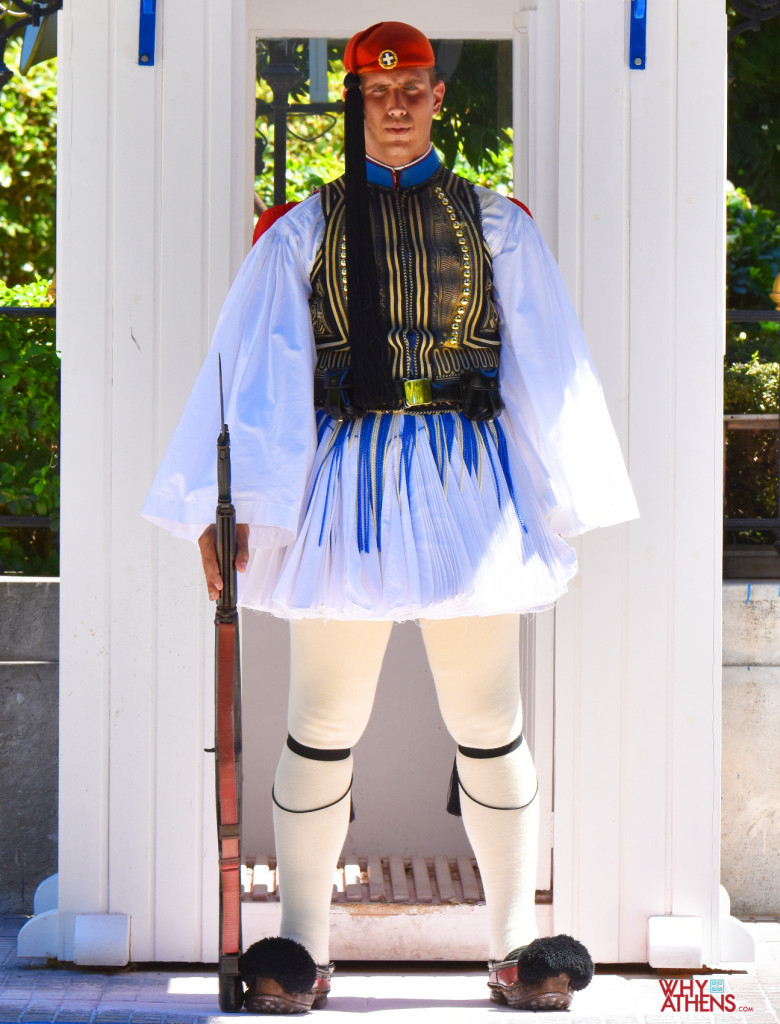 Evzones standing guard at the Greek Presidential palace in their distinctive uniform
Evzones standing guard at the Greek Presidential palace in their distinctive uniform
A Closer Look at the Evzones Uniform Components
The Evzones uniform is not a single garment but a carefully curated ensemble of handcrafted pieces, each with its own significance and story. Let’s break down the key components that make up this remarkable example of greek military uniform.
The Farion: The Iconic Cap
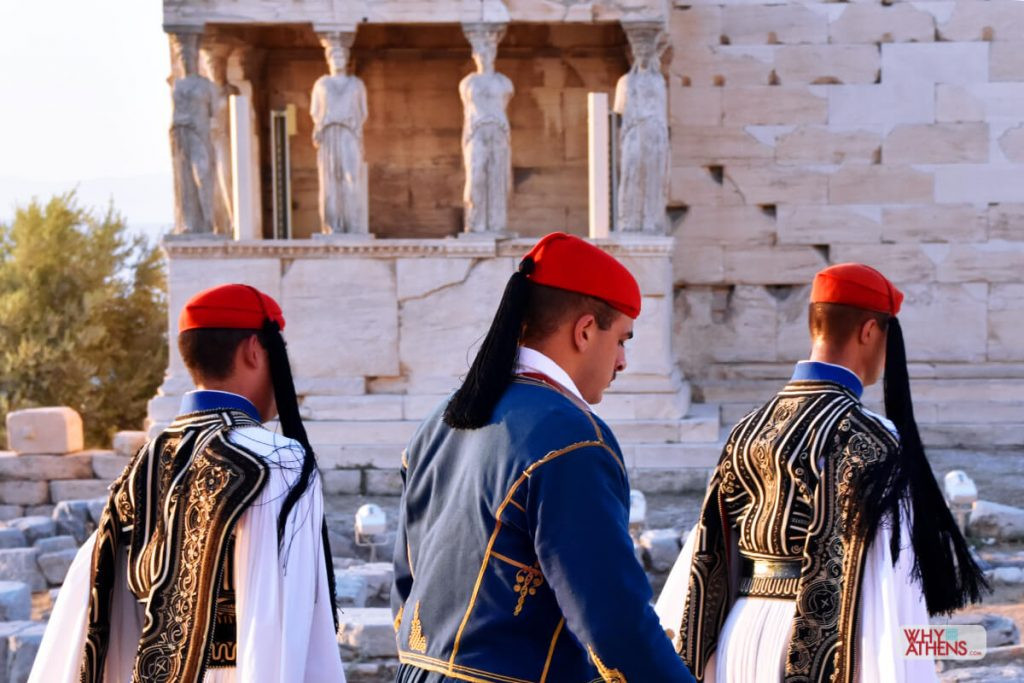 Close-up of an Evzone soldier wearing the Farion cap, showcasing its red color and long tassel
Close-up of an Evzone soldier wearing the Farion cap, showcasing its red color and long tassel
The Farion, the scarlet cap worn by the Evzones, is immediately eye-catching. Crafted from soft red baize, it is distinguished by its long black silk tassel, a feature that can sometimes require careful handling by the soldier after movements to prevent tangling. Interestingly, uniforms representing the Greek islands, often called Cretan uniforms, feature a shorter tassel on their caps. The front of the Farion proudly displays the Greek coat of arms, with an officer’s rank subtly indicated underneath. During salutes, Evzones point two fingers towards the coat of arms, a gesture of respect and allegiance.
The Fermeli: A Vest of Intricate Detail
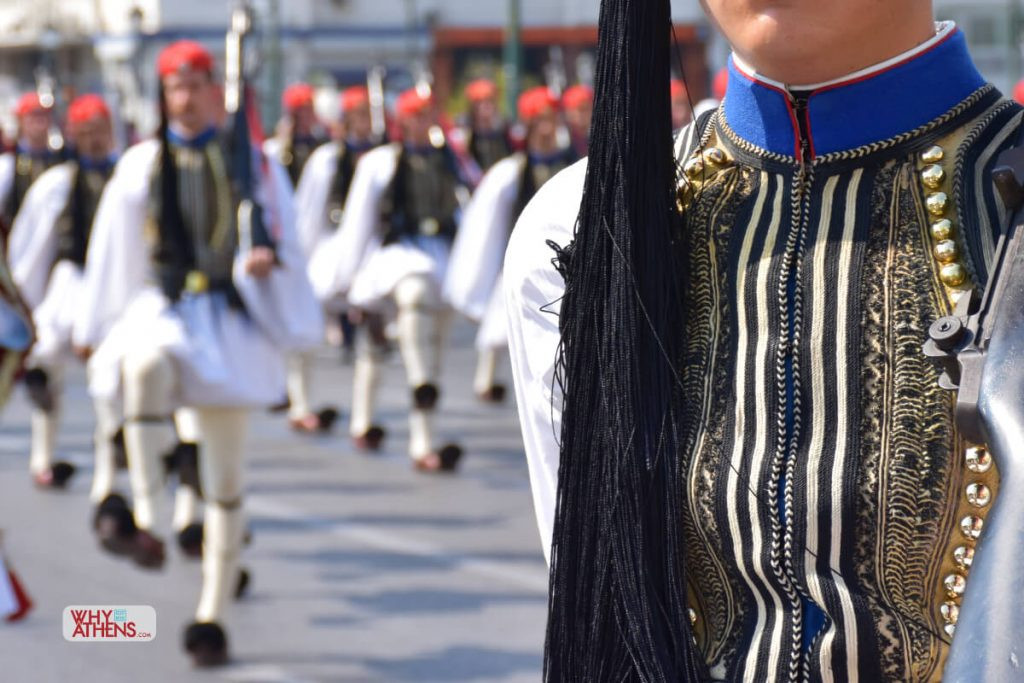 Detailed view of the Fermeli vest, highlighting the wool embroidery and craftsmanship
Detailed view of the Fermeli vest, highlighting the wool embroidery and craftsmanship
Perhaps the most elaborate element of the greek military uniform is the Fermeli. This waistcoat is entirely hand-embroidered from wool. The craftsmanship is exceptional, with thousands of stitches meticulously applied and hidden on the reverse side. Creating a Fermeli can take months, and these durable vests can last up to a decade. Beyond its aesthetic appeal, the Fermeli also subtly denotes rank. While not immediately obvious, stripes at the back right tail of the coat indicate rank: one stripe for a Corporal, two for a Sergeant, and no stripes for Privates.
The Ypodetes: Sleeves of Symbolic Purity
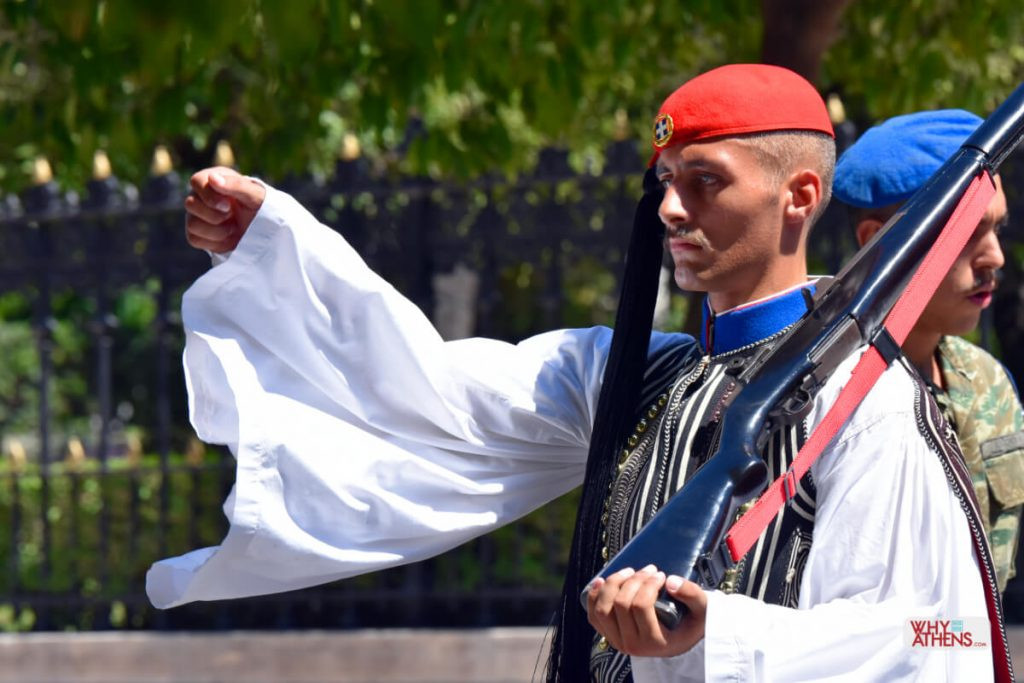 An Evzone soldier marching, showing the flared Ypodetes sleeves in motion
An Evzone soldier marching, showing the flared Ypodetes sleeves in motion
The Ypodetes is the wide-sleeved white shirt worn under the Fermeli. Its generous sleeves flare dramatically during the Evzones’ precise marches. This design is believed to symbolize the purity of Greece’s national purpose. Beneath the wide sleeves, a button-down long sleeve extends to the wrist, adding another layer to the uniform.
The Foustanella: A Skirt Rooted in History
 The Foustanella skirt with its numerous pleats and blue and white Krossia fringes
The Foustanella skirt with its numerous pleats and blue and white Krossia fringes
The Foustanella, a kilt-like garment, is a prominent feature of the greek military uniform. It is crafted from over 30 meters of fabric and boasts 400 pleats. These pleats are said to represent the 400 years of Ottoman occupation and Greece’s subsequent liberation. The Krossia, or braided fringes, are in blue and white, mirroring the colors of the Greek flag. The origin of the Foustanella is debated, with similar garments existing in other Balkan countries. However, historical evidence, including Byzantine-era vases and sculptures from Attica dating back to the 5th century BC, suggests its deep roots in Greek territories.
The Tsarouchia: Shoes That Echo Battle
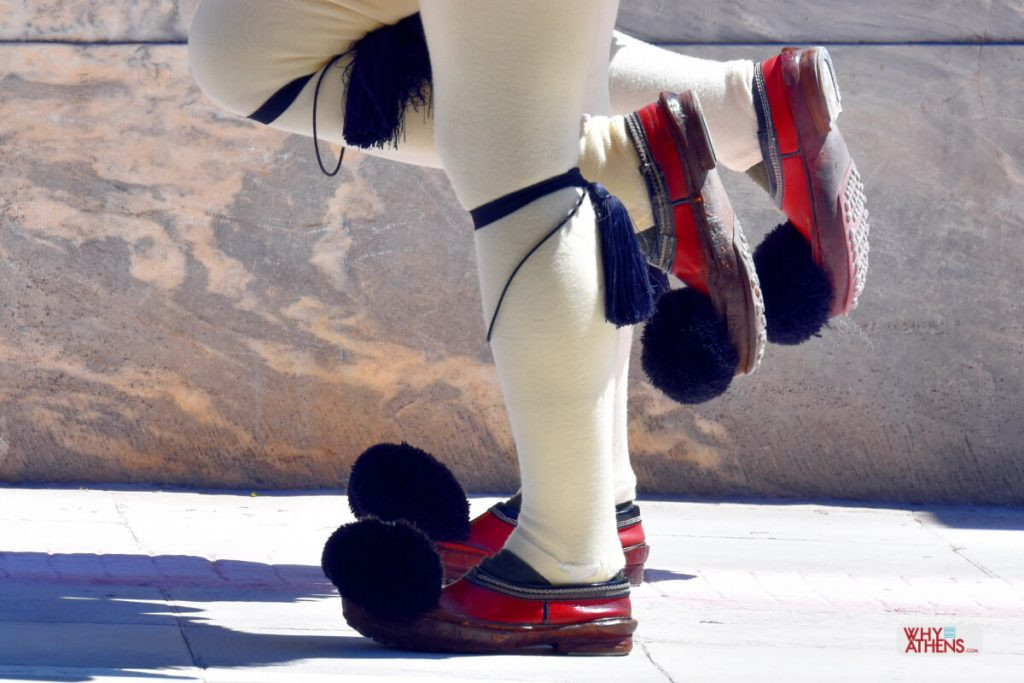 Close-up of the Tsarouchia shoes, showing the upward-pointing toe and black silk pom-pom
Close-up of the Tsarouchia shoes, showing the upward-pointing toe and black silk pom-pom
The Tsarouchia are the distinctive shoes worn by the Evzones. Weighing over three kilograms each, they are equipped with at least 60 nails in the base. These nails are designed to create a resounding sound during the Evzones’ movements, evoking the echoes of battle. The Tsarouchia’s toe is pointed upwards and adorned with a black silk pom-pom, hand-cut to shape. Constructed from cowhide and requiring over 300 hand stitches per shoe, the Tsarouchia are a testament to traditional shoemaking. Evzones wear two pairs of woolen stockings, Periskelides, on each leg, held up by silk garters, Epiknemides, which are also tasseled.
The M1 Garand Rifle: Beyond Ceremony
 An Evzone soldier holding the M1 Garand rifle, highlighting its weight and role
An Evzone soldier holding the M1 Garand rifle, highlighting its weight and role
Each Evzone carries the M1 Garand rifle, a weighty piece of equipment at over five kilograms. It is slammed onto the shoulder at the end of every movement, adding to the physical demands of the Evzones’ duties. While primarily ceremonial, the rifle also plays a practical role. An auxiliary soldier in army fatigues supports the Evzones, managing crowds, adjusting uniforms, and ensuring their well-being during their hour-long shifts in varying weather conditions. If an Evzone needs assistance, they can signal by subtly moving, which the support soldier detects by the sound of the rifle butt hitting the ground. Communication is then established through blinking: one blink for “yes,” two for “no,” and three for “I don’t know.”
Variations of the Evzones Uniform
Beyond the formal ceremonial uniform, there are variations worn by the Evzones depending on the occasion and season.
The Daily Uniform: Doulama for Everyday Duty
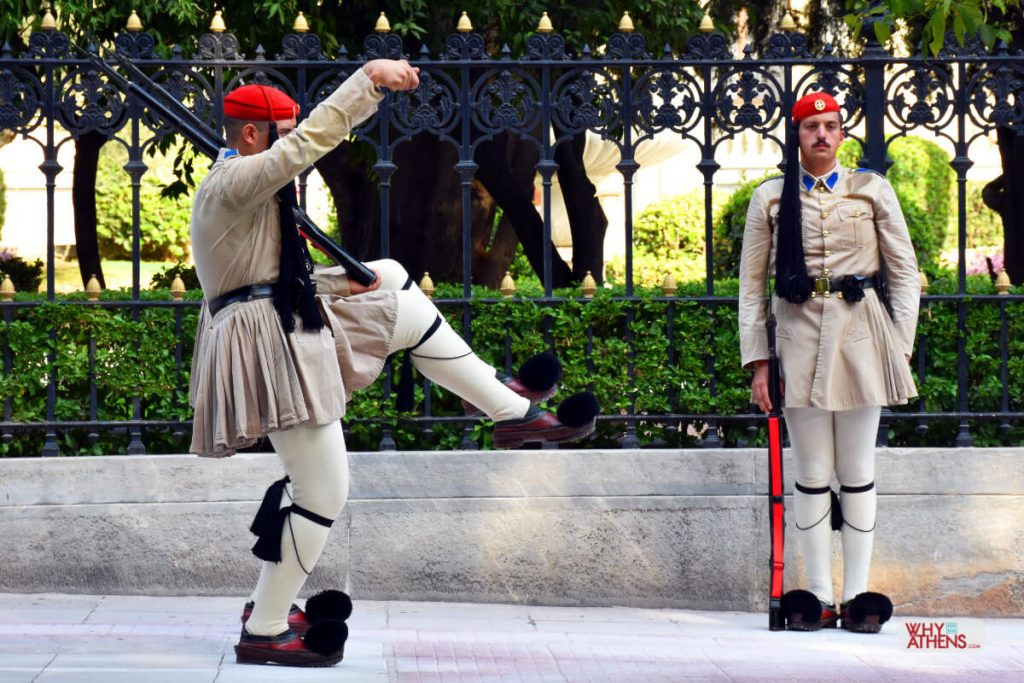 An Evzone soldier in the khaki summer doulama uniform
An Evzone soldier in the khaki summer doulama uniform
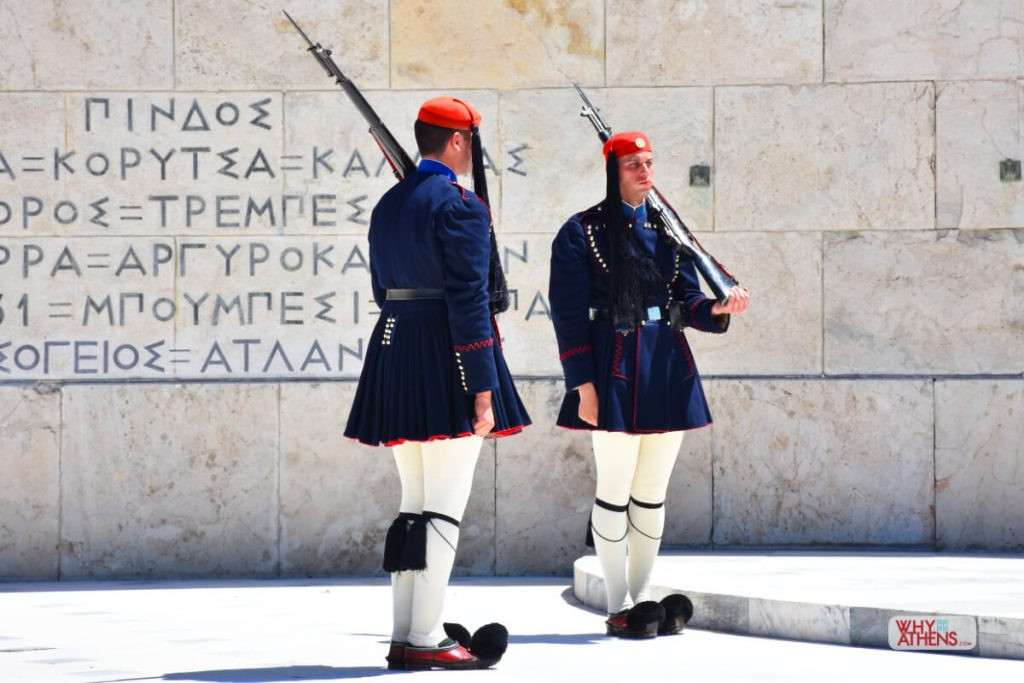 An Evzone soldier in the navy blue winter doulama uniform
An Evzone soldier in the navy blue winter doulama uniform
For duties from Monday to Saturday, excluding special national holidays or welcoming dignitaries, Evzones wear the doulama, a tunic-style uniform. This greek military uniform variation is paired with the tsarouchia, epiknemides, farion, and the Garand rifle. The summer doulama is khaki-colored and made of cotton, while the winter version is navy blue and crafted from wool, its origins tracing back to the Macedonian Struggle of 1904.
The Islands Uniform: Honoring Greek Heritage
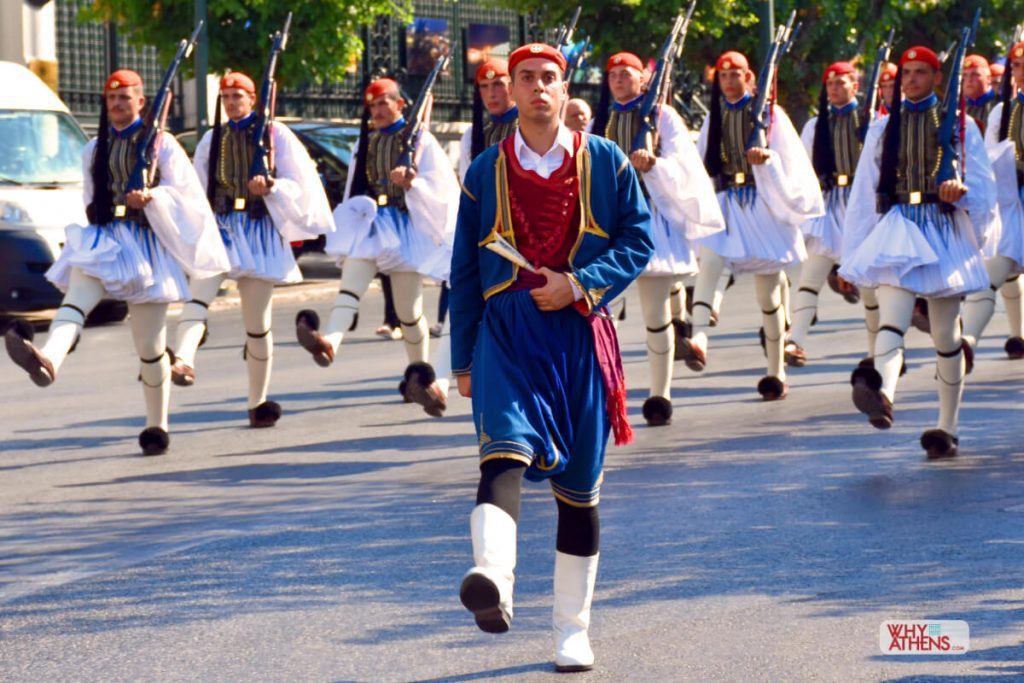 An Evzone soldier wearing the Islands uniform, representing Cretan and island traditions
An Evzone soldier wearing the Islands uniform, representing Cretan and island traditions
The Islands uniform, often referred to as the Cretan uniform, is worn on Sundays and special occasions to honor the contributions and struggles of the Greek islands. The wearer is called a Vrakoforos, a term applied to many traditional island uniforms. This uniform includes a Cretan coat and vest, a Cretan battle knife, distinctive blue breeches, and white leather boots. Additionally, on May 19th each year, Evzones wear a black Pontic uniform to commemorate the Pontic genocide.
The Officer’s Uniform: Distinguished Leadership
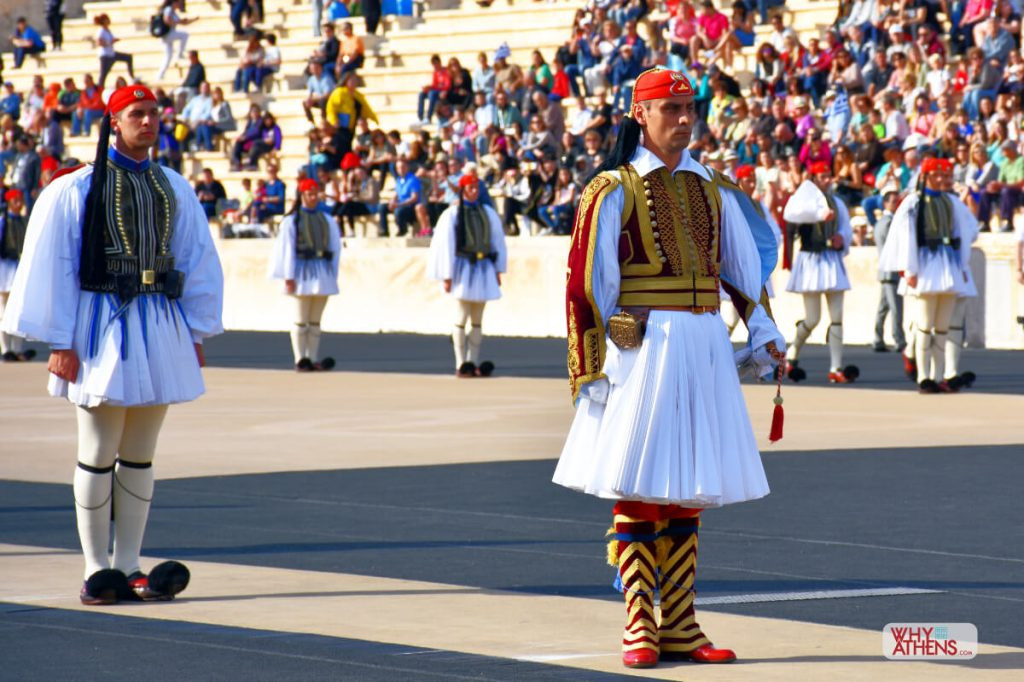 An Evzones officer in their distinct and more ornate uniform
An Evzones officer in their distinct and more ornate uniform
Evzones officers wear a distinct and more ornate version of the greek military uniform. Their Foustanella is knee-length with 400 pleats, and the Fermeli is royal purple with gold embroidery. Red stockings (Epiknemides) and red and gold knee-high boots, along with blue silk garters, complete the officer’s attire. Officers also carry a traditional sabre from the 1821 War of Independence and their Farion cap displays their rank beneath the Greek coat of arms.
Witness the Evzones Uniform in Person
To truly appreciate the grandeur of the greek military uniform, witness the Evzones in person. The Grand Changing of the Guard parade takes place every Sunday at 11 am at the Hellenic Parliament in Syntagma Square. Experiencing this ceremony is a memorable way to connect with Greek history and culture.
Why Athens Airport Transfer Taxis Why Athens Sailing Catamaran Tour
Related Articles

